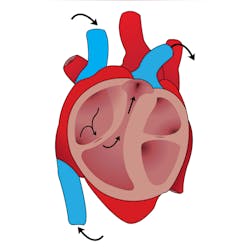Researchers at The Ohio State University Wexner Medical Center have new insights into how the heart’s sinoatrial node (SAN), the body’s natural pacemaker, and its electrical signals are affected during heart failure, according to a news release from the medical center.
The SAN sends electrical signals through the heart, causing it to contract and pump blood. The researchers focused on the SAN’s fibroblasts, which are cells that generate connective tissue, help heal wounds and produce collagen. Using explanted human hearts, researchers found SAN fibroblasts in diseased hearts were more prone to produce fibrosis and a denser variety of it than in healthy hearts. This can impair the delivery of electrical signals to the atria.
After creating an extensive database of proteins and genes found in failing and non-failing SANs, researchers identified specific proteins and myofibroblasts found only in diseased hearts.
The research, published in the American Heart Association’s Circulation, provides a comprehensive framework for future studies to investigate the role of SAN-specific fibrosis in heart rhythm regulation and arrhythmias. The hope is that these findings will help lead to the development of new treatments for heart failure, which affects about 6.2 million adults in the United States.
“Up until this point, little was known about fibroblasts in the human SAN. This is the first study to examine SAN fibroblasts to determine if there are quantitative and qualitative characteristics that uniquely enable them to secrete and maintain the high levels of connective tissue found in the SAN. We know healthy adult human SANs are made of up to 45% of dense connective tissue. When that number increases to 50% or more, you start to see SAN dysfunction, and a pacemaker needs to be implanted to restore the heart’s regular rhythm,” said Vadim Fedorov, Professor of Physiology and Cell Biology at the Ohio State University College of Medicine.
Future studies are needed to determine whether inhibiting or increasing one of the identified proteins during heart failure progression can prevent some of the SAN dysfunction and reduce the need for pacemakers.
Researchers used human hearts donated for research by organ donor families through Lifeline of Ohio and by heart failure patients of the Ohio State Wexner Medical Center Division of Cardiac Surgery.

